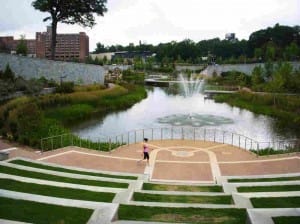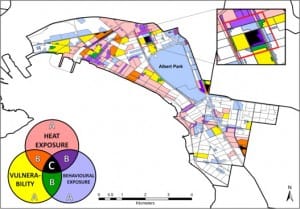Using green infrastructure to deal with high temperatures
 Strategic planning for a heatwave, also known as an extreme heat event (EHE), needs to include more permanent infrastructure such as street trees and green roofs, according to a recent publication by CRC for Water Sensitive Cities researcher Dr Andy Coutts and his collaborators from Monash University and the University of Melbourne.
Strategic planning for a heatwave, also known as an extreme heat event (EHE), needs to include more permanent infrastructure such as street trees and green roofs, according to a recent publication by CRC for Water Sensitive Cities researcher Dr Andy Coutts and his collaborators from Monash University and the University of Melbourne.
Published in the February 2015 edition of the Landscape and Urban Planning journal, Planning for cooler cities: A framework to prioritise green infrastructure to mitigate high temperatures in urban landscapes explores the mitigating effects of green infrastructure on urban air and surface temperatures.
The article outlines a step-by-step approach on how to strategically implement green infrastructure, using a Melbourne local government as a case study, to deliver the greatest benefit from investment in terms of temperature reduction.
While many governments are planning for extreme heat events with a focus on short-term preparation and prevention, “increasing the amount of vegetation, or green infrastructure, in a city is one way to help address the root cause of the problem”.
 “However, to substantially reduce the impacts of increased urban densities and urban heat island effect, widespread implementation of green infrastructure is required. For example, measurements during a heat wave in Melbourne, Australia, suggested a 10% increase in vegetation cover could reduce daytime urban land surface temperatures by approximately 1°C.”
“However, to substantially reduce the impacts of increased urban densities and urban heat island effect, widespread implementation of green infrastructure is required. For example, measurements during a heat wave in Melbourne, Australia, suggested a 10% increase in vegetation cover could reduce daytime urban land surface temperatures by approximately 1°C.”
Dr Coutts is a member of the Water Sensitive Urban Design and Urban Microclimate (Project B3) team.